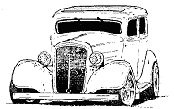He was defined physically by his famous sandals, shorts, and black horn-rimmed glasses. He was defined on the page by right-place-at-the-right-time photography and his colorful Gray-speak, a combination of ’50s slang, hot rod lingo, and his own unique vocabulary. He was defined overall by his love for anything related to hot rodding, from the salt to the lakes to the strip to the street. He experienced it all and turned around and told the rest of the world—or anybody who wanted to listen—all about it.
On February 1st, Charles Gray Baskerville, whose words and photos filled the pages of this magazine and our sister magazine, Hot Rod , for almost 35 years, passed away from complications of cancer at the age of 66.
Gray was born August 16, 1935, in Los Angeles. He grew up in Hermosa Beach, south of L.A. By the time he was old enough to drive, hot rodding had exploded in Southern California, and Robert Petersen was getting the word out with Hot Rod magazine.
Gray’s family was in the performance-magazine biz before Petersen was even born. His grandfather had been publishing Motorcyclist magazine since 1919 (the magazine was eventually purchased by Petersen). When Gray graduated from the University of California at Santa Barbara in 1958, he began writing for Motorcyclist.
In the early ’60s, Gray, along with Paul Horning and Ernie Murashige, campaigned a B/Altered Model T roadster pickup in addition to owning a few hot rods. Gray’s professional background and his passion for hot rods landed him a job at Petersen Publishing. On July 16, 1968, he began writing special-issue magazines, repair manuals, and Hot Rod annuals for the Specialty Publishing Division.
When Rod & Custom was revived in 1972, Tom Medley hired Gray onto the staff. It was a smart move. Rodding was rolling in some very untraditional directions in the early ’70s, but Gray’s roots in the ’50s and ’60s benefited the magazine. When R&C was discontinued again in 1974, Gray transferred to Hot Rod, where he spent the rest of his career.
Vastly appreciated by his readers, Gray was underappreciated by many hot rod industry bigwigs, including a few within the company he worked for. It didn’t seem to make him bitter, just disappointed that people didn’t get it. Never aspiring to be a bigwig himself allowed him to keep doing what he loved—hanging around hot rods. By the time he retired as a full-time employee in November 2000, Gray had perfected a writing style that clearly communicated his passion. It wasn’t journalism; it was a devoted hot rodder so excited about what he’d seen that he couldn’t wait to tell everybody.
After he retired, Gray kept his office and continued to contribute stories to Hot Rod and R&C. His office has been cleaned out and reassigned now, but we still half-expect to hear him chatting on the phone with a rod builder or flip-flopping down the hall to talk to one of us about hot rods. It’s going to take awhile for that to go away.
Gray didn’t live long enough, but he did live life with everything he had. At the end, he insisted that there be no memorial service. “My life was the celebration,” was how he put it. He was an original and the most enthusiastic hot rodder in the world. He was a sage, a nut, a beatnik, a preacher, radical, reactionary, the eternal teenager, and yer ol’ dad.



 Gray Baskerville
Gray Baskerville



 Gray Baskerville
Gray Baskerville